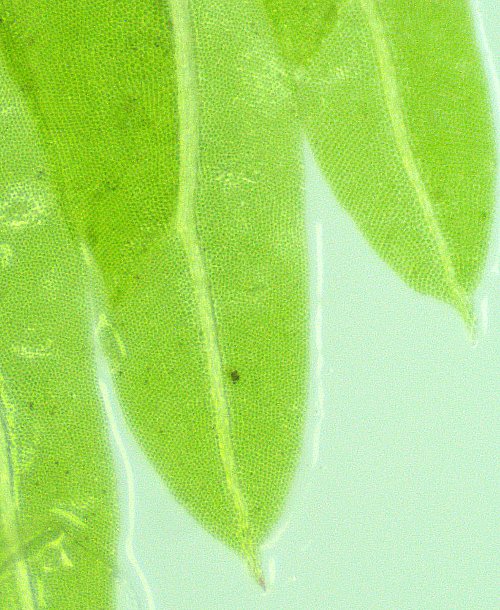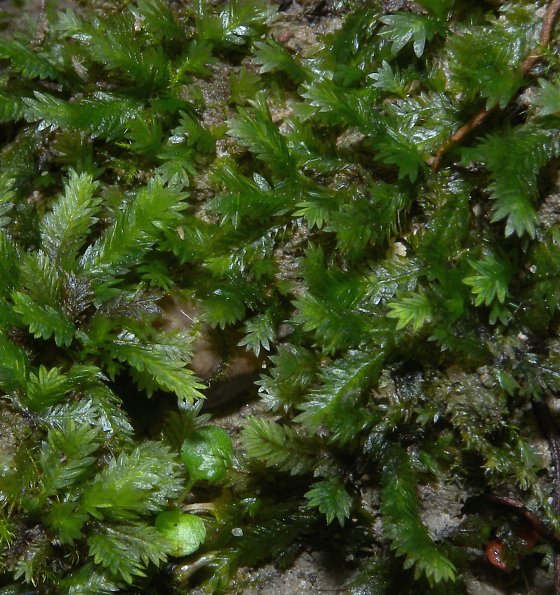
The solitary sporophyte (spore-bearing capsule and its stalk) originates from the base of the leafy stem and extends above apex of the leafy stem. The slender stalk (seta) is 8-16 mm. long, light green to red, terete, and ascending to erect. At the apex of the stalk, there is a spore-bearing capsule about 1–1.5 mm. long; it is held erect or at a lateral angle (usually the latter). The hairless capsule is cylindrical and slightly obconic in shape; it is slightly wider at the apex than the base. Immature capsules are light green, but they later become dark red or reddish brown. The lid (operculum) of the capsule has a long narrow beak; it is late-deciduous. The membranous sheath (calyptra) covers both the lid and the upper portion of the capsule; it is long-beaked, hairless, and early-deciduous. Along the upper rim of the capsule, there is a yellow ring of cells (annulus). When the lid becomes detached from the capsule, a ring of reddish incurved teeth is revealed. These teeth are linear-lanceolate in shape and minutely bumpy (papillose) along their margins. The spore-bearing capsules develop and mature during the autumn and possibly other times of the year if conditions are favorable. Each capsule contains an abundance of tiny spores; they are dispersed by the wind. Individual spores are 12-18 micrometers in diameter, globoid in shape, and minutely bumpy (finely papillose). The base of the plant is anchored to the ground by fine rhizoids. This moss often forms of colonies of plants.

Cultivation: The preference is light to medium shade, wet to moist conditions, and soil containing clay or gravelly clay. Soil containing clay-loam or loam is also acceptable in moist protected areas. This moss has been used as an aquarium plant, however it is not usually found in water.
Range & Habitat: The native Yew-leaved Pocket Moss (Fissidens taxifolius) is scattered across Illinois, where it is occasional to locally common (see Distribution Map). This moss is widely distributed in North America, South America, and Eurasia. In Illinois, habitats for this moss include ground soil of woods, earthen banks in woods, areas along woodland paths, moist shaded ground along woodland borders, slopes and bottoms of ravines in woods, disturbed soil at the base of fallen trees in woods, thin soil on decaying logs in woods, thin soil along moist shaded ledges, swampy woods, calcareous hillside seeps, shaded hillside gullies, clay banks of streams, submerged in water of streams, and ditches. This moss is rarely found on rocks or tree bark, even in moist shaded situations. Yew-leaved Pocket Moss occurs in both high quality natural areas and natural areas that have been subjected to moderate amounts of disturbance.

Faunal Associations: The Trumpeter Swan feeds on Fissidens spp. (Pocket mosses) that are either aquatic or shoreline plants; see Schorger (1964). However, Yew-leaved Pocket Moss (Fissidens taxifolius) rarely grows in water in Illinois, nor is it often found along exposed shorelines of larger bodies of water. In an experiment in Great Britain, it was found that Yew-leaved Pocket Moss is more common in chalk grassland areas that were exposed to herbivory by rabbits. When such grassland areas were fenced off to keep rabbits away, this moss became less common, probably because of increased competition from other plants (Watt, 1957).
Photographic Location: A shaded hillside gully and bottom of a ravine in Vermilion County, Illinois. Close-up photographs were taken with a microscope indoors.

Comments: Yew-leaved Pocket Moss (Fissidens taxifolius) is one of the more common Pocket mosses (Fissidens spp.) in Illinois. Because of their two-ranked leaves, Pocket mosses resemble miniature ferns. They are unusual among mosses because their leaves have sleeves (folded basal lobes) that partially contain neighboring leaves. Among species in this genus, Yew-leaved Pocket Moss is medium-sized. It can be difficult to distinguish this moss from another species, Bush's Pocket Moss (Fissidens bushii). This latter species is a slightly smaller moss with shorter leaves (1–1.5 mm. in length, rarely to 2 mm.). The narrow leaf tips of this species are shorter and less developed than those of Yew-leaved Pocket Moss. The midrib of Bush's Pocket Moss extends just short of the leaf tip; the narrow elongated cells of its midrib are replaced with short angular-hexagonal cells that are more typical of its leaf blade, even though its midrib and leaf tip are both predominately pale (requires magnification of a microscope to see). In contrast, both the midrib and leaf tip of Yew-leaved Pocket Moss have narrow elongated cells. Other Pocket mosses differ from Yew-leaved Pocket Moss by having one or more of the following characteristics: 1) their stalked spore-bearing capsules are produced from the tips of leafy stems, rather than near the bases of leafy stems, 2) their leaves are longer or shorter than those Yew-leaved Pocket Moss, 3) the midribs of their leaves do not extend all of the way to the leaf tips, 3) their leaf margins have conspicuous pale borders, 4) their leaves have conspicuous teeth near their tips, and 5) their capsules and/or stalks are longer or shorter than those of Yew-leaved Pocket Moss.